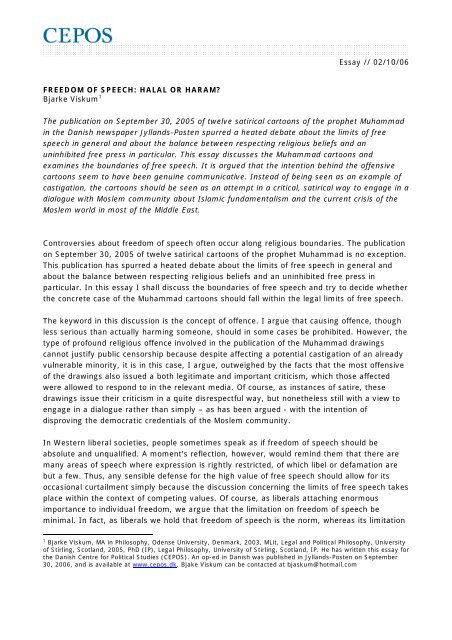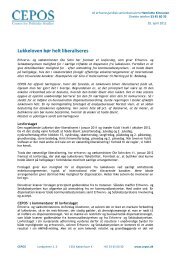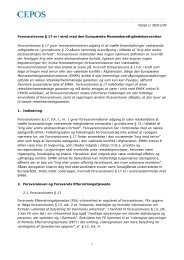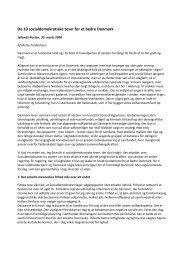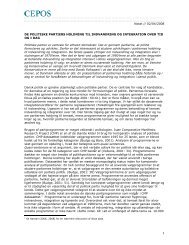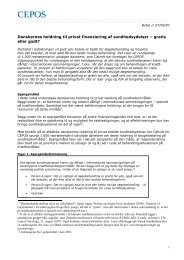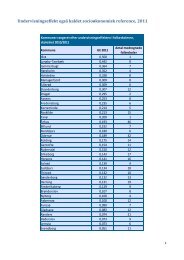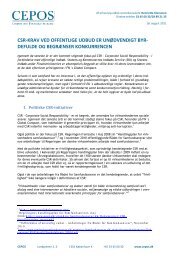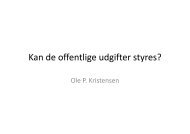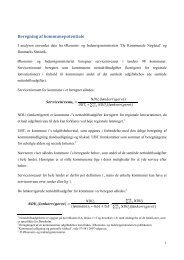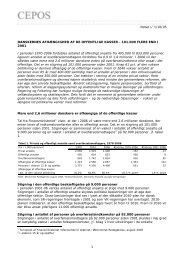FREEDOM OF SPEECH: HALAL OR HARAM - Cepos
FREEDOM OF SPEECH: HALAL OR HARAM - Cepos
FREEDOM OF SPEECH: HALAL OR HARAM - Cepos
You also want an ePaper? Increase the reach of your titles
YUMPU automatically turns print PDFs into web optimized ePapers that Google loves.
Essay // 02/10/06<strong>FREEDOM</strong> <strong>OF</strong> <strong>SPEECH</strong>: <strong>HALAL</strong> <strong>OR</strong> <strong>HARAM</strong>?Bjarke Viskum 1The publication on September 30, 2005 of twelve satirical cartoons of the prophet Muhammadin the Danish newspaper Jyllands-Posten spurred a heated debate about the limits of freespeech in general and about the balance between respecting religious beliefs and anuninhibited free press in particular. This essay discusses the Muhammad cartoons andexamines the boundaries of free speech. It is argued that the intention behind the offensivecartoons seem to have been genuine communicative. Instead of being seen as an example ofcastigation, the cartoons should be seen as an attempt in a critical, satirical way to engage in adialogue with Moslem community about Islamic fundamentalism and the current crisis of theMoslem world in most of the Middle East.Controversies about freedom of speech often occur along religious boundaries. The publicationon September 30, 2005 of twelve satirical cartoons of the prophet Muhammad is no exception.This publication has spurred a heated debate about the limits of free speech in general andabout the balance between respecting religious beliefs and an uninhibited free press inparticular. In this essay I shall discuss the boundaries of free speech and try to decide whetherthe concrete case of the Muhammad cartoons should fall within the legal limits of free speech.The keyword in this discussion is the concept of offence. I argue that causing offence, thoughless serious than actually harming someone, should in some cases be prohibited. However, thetype of profound religious offence involved in the publication of the Muhammad drawingscannot justify public censorship because despite affecting a potential castigation of an alreadyvulnerable minority, it is in this case, I argue, outweighed by the facts that the most offensiveof the drawings also issued a both legitimate and important criticism, which those affectedwere allowed to respond to in the relevant media. Of course, as instances of satire, thesedrawings issue their criticism in a quite disrespectful way, but nonetheless still with a view toengage in a dialogue rather than simply – as has been argued - with the intention ofdisproving the democratic credentials of the Moslem community.In Western liberal societies, people sometimes speak as if freedom of speech should beabsolute and unqualified. A moment’s reflection, however, would remind them that there aremany areas of speech where expression is rightly restricted, of which libel or defamation arebut a few. Thus, any sensible defense for the high value of free speech should allow for itsoccasional curtailment simply because the discussion concerning the limits of free speech takesplace within the context of competing values. Of course, as liberals attaching enormousimportance to individual freedom, we argue that the limitation on freedom of speech beminimal. In fact, as liberals we hold that freedom of speech is the norm, whereas its limitation1 Bjarke Viskum, MA in Philosophy, Odense University, Denmark, 2003, MLit, Legal and Political Philosophy, Universityof Stirling, Scotland, 2005, PhD (IP), Legal Philosophy, University of Stirling, Scotland, IP. He has written this essay forthe Danish Centre for Political Studies (CEPOS). An op-ed in Danish was published in Jyllands-Posten on September30, 2006, and is available at www.cepos.dk. Bjake Viskum can be contacted at bjaskum@hotmail.com1
Essay // 02/10/06stands in need of justification. But that there must be limitations is a given, the question israther what the legitimate limitations on free speech are. In this discussion, I shall focus onthe concept of offence, but before that I will shortly address one type of argument that is alltoo often encountered in ethical and legal debates, which is that of the slippery slope.Some liberals might fear for example that any limitation of free speech is the beginning of aslippery slope towards tyranny and censorship, while others might say that if we do not heavilycensure speech, no matter how reasonable the speech, it could incite to public disturbance,and with uninhibited free speech we shall soon end up in a Hobbesian state of nature, wherelife as we know it from Leviathan is ‘solitary, poore, nasty, brutish, and short’. Thus, beforepainting too horrific consequences of our opponents’ views, we should remind ourselves thatthere is always more than one slippery slope. Or to put the point in another way, you cannotget off the slippery slope altogether, the task is rather to decide where on the slope to stay.This reminder seems especially pertinent in the debate over the Muhammad drawings, wherethe one side claims that free speech is not a matter of degree, and the other side holds thatany insult to Mohammad should be prohibited. 2Now, let us first get a clear picture of the situation in the Muhammad debate. In September2005, in a so-called manifestation of freedom of expression, the Danish newspaper Jyllands-Posten (JP) asked a group of cartoonist to draw the prophet as they perceived him to be,which would – as they were clearly aware of - entail violating a well-established Islamictradition against depicting the holy prophet. The openly acclaimed reason for this request wasthe following: The author of a children’s book about the life of Muhammad had apparently beenunable to find anybody who by name would illustrate his book. Thus, in the wake of MichelHouellebecq’s trial and the murder of Theo van Gogh, JP wanted to test whether anatmosphere of self-censorship had emerged in the Danish debate preventing discussion andcriticism of Islam. They received twelve cartoons. Some of the cartoons - undoubtedly themore funny ones - mocked JP and their cultural editor, Mr. Flemming Rose, for initiating thepublication. Others were of a more neutral nature. Two of them, however, have ignited a fireof insult throughout the Moslem world. One of them portrays Muhammad with a bomb in histurban, whereas the other has St. Peter refuse Muhammad at the gate to heaven with thewords: ‘Sorry, we’re fresh out of virgins’. Unsurprisingly, many Moslems – both inside andoutside Denmark – felt deeply offended by the cartoons, and the question is – in this essay atleast, whether these cartoons should fall within the legal scope of free speech? But before I tryto tackle that question, I shall briefly discuss the tradition of religious satire in Western andMoslem societies.Nowadays, in Western Europe, satire or ridicule is generally seen as an impotent way ofundermining religion. Unlike the perception of for example the medieval monks in UmbertoEco’s The name of the Rose (1980), satire is no longer believed to threaten religious faith orpolitical stability. Rather, we have experienced a gradual shift in general orientation from apassionate concern with whether and how far religion should tolerate criticism, to a more2 For a powerful argument against the use of slippery slopes see David Enoch: ‘Once You Start Using Slippery SlopeArguments, You’re on a Very Slippery Slope’, 0xford Journal of Legal Studies, 2001, 21, pages 629-6472
Essay // 02/10/06moderate concern with how far skepticism should tolerate religion. However, it is worthbearing in mind that the Western tradition of criticizing religion has indeed evolved over alonger period of time in Jewish and Christian contexts than in Islam. The slow development ofreligious criticism in Western Europe has proved much easier to absorb than the suddentransformation Islam has experienced in the modern period.This is of course not to say, however, that the Western tradition of satire has not been hardfought. In 1664, Molière’s uncompromising attack upon religious hypocrisy in Tartuffe stirredthe rage of the church and was consequently banned by Louis XIV. However, the opposition torevealed religion gradually increased through such eighteenth century figures as Voltaire andRousseau before Nietzsche in Der Antichrist (1895) unabashedly attacked Christianity as amasochistically disguised urge for power.The rather sudden exposure of Islam to modernity appears all the more damaging in the lightof the comprehensiveness of the Islamic religion with its inclination to exclude distinctionsbetween society and state and between church and government. These facts might thus givethe beginning of an explanation as to why the modern debates over the limits of free speechhas recently so often centered on the clash between Western secularism and Islam.Salman Rushdie’s book The Satanic Verses (1988) was one of the first cases to bring this clashinto the open. However, though there are many similarities between the case of Rushdie andthe later cases of Houellebecq, Theo van Gogh and the Danish cartoons, it is of course anunderstatement to say that the political situation has changed between 1988 and now.Following notably terrorist attacks on New York and Washington DC on September 11, 2001,and the war in Afghanistan and Iraq, we are living in a situation of increased sensibilities, inwhich the preconditions for genuine communication and discussion are often absent. And thepublication of the Danish cartoons should of course also be evaluated on the background ofthis new situation. But the question still remains whether the cartoons should fall within thelegal scope of free speech?Well, on a liberal theory of the criminal law, a first question might be to ask whether anybodyhas been harmed by the publication of the cartoons. 3 Many Moslems have claimed to havebeen harmed. However, following Joel Feinberg’s influential interpretation of the liberal harmprinciple in Harm to Others (1984), it seems implausible to say that anybody has beenharmed. According to Feinberg, harm – in the sense relevant for the criminal law – consists inthe wrongful setback of interests. By interests he importantly understands those basic welfareinterests in physical and psychological health that constitute the preconditions for the pursuit3 However, it might be argued that by taking a liberal starting point, I have already undermined the Moslem case forcriminalizing such types of religious offense from the start. Let me try and explain why. A liberal law emphasisesindividuals, that is, the wrong which is done by say blasphemy is the wrong of offending individuals. In the eyes ofMoslem believers, however, the wrong which is done by blasphemy is a wrong against God. Where blasphemy istolerated, the result is therefore not simply that individual believers are distressed, but rather that God is mocked.Hence, if we begin with the belief that the individual is most important, we will find it rational to conclude thatblasphemous acts are damaging to the extent that they damage individuals, where by contrast if we begin with thebelief that God is most important, we will find it rational to conclude that blasphemy is wrong because it scorns God.As a liberal, I do of course take the former to be more rational than the latter, but this I shall simply assume.3
Essay // 02/10/06of our more ultimate goals and objectives in life. In the case of the Muhammad cartoons, itwould seem exaggerated to claim that anybody’s basic welfare interests have been violatedand consequently that anybody has been harmed in the relevant sense.This is not, however, to say that speech merely in its character as offensive could notwrongfully violate a basic welfare interests and thus constitute harm. If for example somebodyis constantly verbally bullied in school this might amount to harm. However, the character ofthe cartoons is different in this respect because they were not directed at one person. They donot seem to be directed at Moslems as such, but rather at Islamic fundamentalism. But that isa point for later. Now, the important thing to establish is that the publication does notconstitute harm in a sense relevant to the criminal law. However, its mere offensiveness mightstill warrant censorship. Thus, we should therefore have a closer look at the crucial concept ofoffence.In Offense to Others (1988), Joel Feinberg introduces the so-called offence principle, whichstates that: “It is always a good reason in support of a proposed criminal prohibition that itwould probably be an effective way of preventing serious offense (as opposed to injury orharm) to persons other than the actor, and that it is probably a necessary means to thatend”. 4 Under the concept of offence, Feinberg subsumes a group of 'universally disliked mentalstates' the prevention of which might also be desirable. The concept of offence thus covers avariety of annoying or offensive disturbances, which Feinberg divides into six generalcategories: 1) Affronts to the senses, 2) Disgust and revulsion, 3) Shock to moral, religious, orpatriotic sensibilities, 4) Shame, embarrassment (including vicarious embarrassment), andanxiety, 5) Annoyance, boredom, frustration, 6) Fear, resentment, humiliation, anger. 5 Thoughthese states of course differ in their origin and effect, their subsumption under the generalheading of offence is justified by their sharing certain important characteristics:“They are at the very least unpleasant to the one who suffers them, […], they are complexstates whose unpleasantness is in part a function of the tension between conflicting elements.[…] they are nuisances, making it difficult for one to enjoy one’s work or leisure in a localitywhich one cannot reasonably be expected to leave in the circumstances”. 6In addition to the abovementioned different offended states, Feinberg identifies a furthernormative sense of the concept of offence according to which offences in the context of theoffence principle only refers to such states when caused by the wrongful conduct of others.Now, though it is of course clear that these disturbances and annoyances affect us to a muchsmaller degree than say physical assaults or being robbed, we are nonetheless faced with thequestion of whether and by what means the state should protect us from these dislikedoccurrences. Furthermore, some offences such as importantly religious satire have historicallybeen punished in a quite draconian way and though we nowadays often find the legitimacy ofthat punishment more than questionable, this very fact points to a basic legislative question4 Feinberg: Offense to Others, page 15 Feinberg: Offense to Others, page 10-136 Feinberg: Offense to Others, page 21-224
Essay // 02/10/06concerning the legitimacy of an offence principle to which the liberal must formulate ananswer.Feinberg, however, denies a general interest in the avoidance of offences. This move appearsat first somewhat surprisingly since it seems irrefutable that people have a very real interest inavoiding say shock to their religious sensibilities. But the argument becomes more plausibleonce we understand the difference between harm and offence. The differentiation betweenharm and offence must be understood in the light of Feinberg’s very elaborated concept of anetwork of interests: The basic welfare interests only covers our basic interests in sustaining aminimum of physical and mental welfare and their violation amounts to harm, but it wouldindeed be an exaggeration to claim that the avoidance of for example something physicallynauseating or a religious shock is vital to sustaining our basic welfare; the ulterior interests onthe other hand seek to realize certain more complex long term life plans and goals and themomentous instances of nuisances seem in this context without any weight.Now, there are of course some extreme forms of nuisances, which affect the person concernedto a degree amounting to harm. Constant humiliations at one’s workplace might for exampleresult in a severe depression. However, although the harm is caused by offensive behavior, itis nonetheless still the occurrence of a harm that merits the actions criminal and not theoffence as such.As should be clear by now, Feinberg finds offences to be a lesser evil than harms. This, hesays, is an “evident, but unprovable truth”. 7 In the light of the aforementioned differentiationof interests, however, we should be able substantiate this allegedly unprovable truth: if theprotection of interests constitute the indispensable element in fulfilling a human beings’ goalsin life and furthermore that the justification for the criminalization of the violation of interestsis based on the fact that these very violations are the most serious infringement of theindividual’s personal sphere, we must on the other hand conclude that since causing offencesare as we have seen conceptually separate from violating interests, they pose a less seriousinfringement of the personal sphere.Until now it has been shown that the concept of offence can be separated from the concept ofharm and that causing offence is less serious than causing harm. Therewith, however, is ofcourse nothing said as to whether offences should be criminalized at all. The moral legitimacyof state coercion against causing offence is not to be found in any grave consequencesfollowing the offence, but rather in the intuitive intensity with which we react towards offences.Feinberg starts out by airing a certain amount of skepticism concerning the criminalization ofoffences: “It may well be that the criminal law need not concern itself at all with definingcrimes of offensiveness, even though offensiveness is the sort of evil it could in principle beused legitimately to combat”. 8 Hence, only if other modes of regulation such as injunctions fail,should offensive behavior be punished and even in those cases only by the most moderateforms of punishment. The function of the offence principle is thus both to legitimate and limit7 Feinberg: Offense to Others, page 38 Feinberg: Offense to Others, page 45
Essay // 02/10/06punishment of offences: the state should possibly punish certain offences but in those casesonly by using the most moderate means. This limiting function becomes clearer as Feinbergintroduces the mediating maxims that govern the application of the offence principle.The normative limitation of offences is determined by balancing the seriousness of the offencewith the reasonableness of the offending conduct. Feinberg presents us with following schemafor mediating the offence principle:The seriousness of an offence is determined by the following standards: 1) The magnitude ofthe offence including its intensity, duration and extent, 2) the avoidability of the offence, 3)volenti non fit iniuria, that is, the volenti maxim: 'to one who has consented, no wrong isdone', and 4) the discounting of abnormal susceptibilities. Having assessed the seriousness ofthe offence it must be balanced against the reasonableness of the offending conduct, which isdetermined by the following standards: 1) The personal importance of the offending conduct,2) the social value of the offence, 3) the value of free expression, 4) the availability ofalternatives, 5) the motivation behind the conduct and finally 6) the nature of the locality. 9The balancing scheme therefore emphasizes compromises as the indispensable requisite forpeaceful co-existence between members of complex modern societies.Now, so far our discussion of the offence principle has despite the disparity of types of offencesassumed a general feature to be present in all cases of offence: the feeling of offence isproduced directly at the sight of the offensive behavior. However, besides these general casesof offence, there are special cases to which the mediating maxims are not directly applicable.Unlike normal offensive nuisances, there are types of profound offences that continue to beoffensive whether witnessed or not. Thus, the volenti maxim does not apply to profoundoffences. The question of criminalization of profound offences is accordingly subject to aseparate treatment.Offences that exclusively affect our senses are obviously dependent upon the immediateperceptual experience of the offended party. But with affronts to our moral senses it is ofcourse otherwise. The feeling of offence is in these cases affected by the mere knowledge ofthe offensive behavior. Feinberg characterizes this type of offence as profound offence. Thedifference between offensive nuisances, merely, and profound offences is that while profoundoffences offend because they are believed to be wrong, offensive nuisances are believed to bewrong simply because they offend.The reactions affected by profound offences are as already mentioned caused by the moralsensibilities. The aggrieving aspect of these offences is the open and aggressive pursuit ofmorally disapproved standards. However, from a liberal point of view, the very fact that themoral and political beliefs of the offender is involved should count as a serious argumentagainst state coercion because the realization of the core liberal values of religious and political9 Feinberg: Offense to Others, page 35 and 446
Essay // 02/10/06freedom and of freedom of speech is the foundation of the liberty limiting principles. In theconflict between fulfilling one’s concept of the good life and thereby affecting impairments ofother people beyond the harm principle, there is always a presumption in favor of the latter.This presumption is justified in virtue of the fact that profound offences do not normally causepersonal grievance; they are not directed at the offended person but rather at her beliefs. “Theoffence-causing action, [however], must be more than wrong; it must be a wrong to theoffended party, in short a violation of her rights”. 10 The adherents of the criminalization ofprofound offences must therefore employ illiberal morals to protect the affected offendedpersons. Thus, profound offences can basically not be criminalized on the basis of liberalprinciples.An exemption from this general rule is some forms of provocations in which the offenderdeliberately seeks out the offended party and merely seeks to offend. In these cases it seemsappropriate to characterize the offended party as a victim. Furthermore, in its character ofbeing merely offensive, this type of behaviour is without any social value and thereforelegitimately punished under the mediating maxims governing the offence principle.Thus equipped with a deeper understanding of the nature of offence and especially profoundoffence, we can try to evaluate whether the concrete case of the Muhammad cartoons shouldfall with the legal limits of free speech. However, before evaluating the actual case, let us firstfor example imagine that the two most offensive cartoons were not just published in anewspaper but hung on giant billboards in all major cities in Denmark. Should that be allowed?And let us furthermore imagine that some of these billboards not ‘only’ portrayed Muhammadas a suicide bomber, but also as a pedophile and as a pig. I would say that both examplesshould be prohibited. The reason being that large billboards make the Moslem community acaptive audience to pictures they are deeply offended by. They are not free to avoid beingoffended. Thus, I do believe some things should be prohibited merely on the grounds of itsoffensiveness. Of course, my two imaginary examples might invite the thought: ‘the cartoonswere published in a private newspaper, which even had a warning on the front-page, whycould we not reply to the offended Moslems: if you want to avoid being offended, just do notbuy the newspaper’? Liberals often use the same line of argument against prohibitingpornography: ‘If you know pornography offends you, just do not buy pornographic magazinesor videos’. However, this reply misunderstands the nature of the offence involved in theMuhammad cartoons (as it might also misunderstand the nature of pornography, but that isanother story). The Moslem community finds the satirical cartoons of Muhammad profoundlyoffensive, that is, it is the mere fact that the cartoons have been published and that itsviolation is legal that the majority of the Moslem community finds offensive. Thus, to arguethat Moslems could easily avoid being offended simply by averting their gaze away from thenewspaper fails to appreciate the special type of offence involved in this case.10 Feinberg: Offense to Others, page 687
Essay // 02/10/06Now, the crucial question is whether the mere knowledge of the publication of the Muhammadcartoons constitutes a good reason for the prohibition of that offence? A modern secularanswer, of course, would be that susceptibility to offence at the mere knowledge of thatoffence taking place can only very rarely if ever warrant legal interference. And, as alreadymentioned, the liberal should add that the offence-causing action must be more than a wrong,it must be a wrong to the offended party, i.e., it must be a violation of her rights or in otherwords, the crime must have a victim. But who is the victim in this case? Well, as the drawingsonly vilify Muhammad, he can seemingly be said to be the only victim of the crime. Of course,Moslems might claim that their grievance is indeed personal in this case, that the offence isunmistakably directed at them, and that they therefore each individually are the victims of theoffensive behavior. If this is a correct interpretation, we have at least a reason for prohibitingthe cartoons, but in order for it to be a good reason, we should first balance among otherthings the social utility and reasonableness of the offence with the reasonableness of theoffence felt by the victims.But before finally evaluating the concrete case, I should like to introduce a distinction fromHabermas between communicative and strategic actions: If the participants in acommunicative situation adopt the attitude that they will attempt to achieve success withoutthe rational agreement of those persons whose actions they seek to influence, then they areengaged in a strategic action. If they are oriented at reaching understanding, however theyare engaged in a communicative action. I would suggest that pure communicative speechshould always enjoy legal protection, at least as a prima facie principle, whereas pure strategicaction should be unprotected though not always regulated or criminalized. Of course, it mustbe admitted, speech is rarely, if ever, pure communicative or pure strategic, but rather amixture of both. However, speech will in many cases be predominantly communicative orpredominantly strategic, so it does seem possible to distinguish the one from the other.Now in order to illustrate this distinction, let us imagine that JP had published twelve purelyinsulting cartoons of Muhammad portraying him for example as the devil all done with thehidden agenda of inciting a riot in the Moslem world. This would be an example of offensivebehavior which exclusively seeks to manipulate the recipients into a specific response. It wouldin a Habermasian term be an example of a purely strategic action, which there wouldconsequently be good reason for prohibiting. However, JP’s actual publication of theMuhammad cartoons was manifestly not a case of pure insult. Both of the most offensivecartoons issue an important criticism of the way some Islamic fundamentalists use the wordsof Muhammad to justify their suicide bombings. This form of criticism is not just allowed; it isindeed morally required. The manner in which the criticism has been posed is admittedly lessthan elegant, but the essential point is that the cartoons do have an important message tocommunicate.However, it might still be objected that though criticizing Islamic terrorism is legitimate, thatdoes not justify the use of satire. The same point could have been made in a less offensiveway. I would readily concede that point, but argue that whereas there might be a case forcensuring purely religious satire, especially in those cases where the satire only serves to mock8
Essay // 02/10/06and ridicule, this was an instance of political satire that every group in society must be able totolerate. The fact that the satire in this case also involved the mocking of a religious figure wasto some extent unavoidable, exactly because of the fusion of religion and politics thatdominate nearly all Moslem countries.Furthermore, rather than seeing the cartoons as castigating and excluding a minority, theycould be seen as integrating the Moslem community into the tradition of satire that flourishesin Denmark and which distinguishes the way Danes treat each other. Thus, rather than beingexcluding, the cartoons could be seen as including Moslems by treating them as equals. Itmight be objected that this form of argument presupposes a situation of equality that simplydoes not exist as of yet. Moslems are as a less empowered minority not in a position ofequality. However, offended Moslems have indeed been given the opportunity to respond tothe cartoons in the relevant media. The fact that Denmark experienced virtually no publicdemonstrations following the publication also seems to confirm that the Moslem community isactually heard and more empowered than many critics think. Only the powerless seek to thestreets and demonstrate. Is one being heard on all channels and stations, demonstrationsbecome more or less superfluous.Lastly, it could be objected that JP should have foreseen the harm affected by the cartoons andrefrained from publishing them on those grounds. However, though JP of course could foreseesome disturbances, the extent of the disturbances could certainly not have been imagined bythe newspaper. The demonstrations and attack on Danish embassies and representations seemto a high degree to have been politically rather than religiously motivated, which the long timeperiod between the publication and the demonstrations only seem to confirm. And,importantly, even if the violent demonstrations could have been foreseen, we must still askthis form of violent response was appropriate? This answer to this question must surely be thatmere offense does not justify harmful demonstrations that involve and incite to murder.In conclusion, though the cartoons as a communicative act have been unsuccessful, as manyMoslems believe the offensive cartoons suggested that all Moslems are potential suicidebombers, there is no reason to doubt neither the cartoonist nor JP that this was not theirintention. The intention behind the offensive cartoons does seem to have been genuinecommunicative. Instead of being seen as an example of castigation, the cartoons should beseen as an attempt in a critical, satirical way to engage in a dialogue with Moslem communityabout Islamic fundamentalism and the current crisis of the Moslem world in most of the MiddleEast.9


